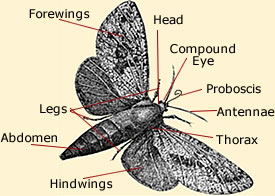Form and Function (Adaptation)
How has this organism adapted to its environment?
As far as adaptation goes, there is not too much
information specifically about the Clark's Sphinx. Although,
moths tend to follow the same pattern when adapting to specific
environments. Climate change is a huge factor of how organisms
adapt to their environment. Some can not handle an extreme
change in climate, especially the larger organisms because they
tend to evolve at a slower pace (Campbell and Reece 2008). If a moth is smaller
for example, the moth is able to have multiple generations on
its journey. If the moth is larger in size like the Clark's
Sphinx, body size protects them from changes in the environment.
The Sphinx structure helps it to survive in its habitat due to
the shape and size, which is also why this organism lives in
surrounding areas for the course of its life.
What is the description of this organism's body?
The form of the moth is very important because this is
what makes the Clark's Sphinx capable of
movement and also as a means of survival. Not only does this
relate to the Clark's Sphinx, but for the generalized group of
moths as a whole. A moth has three main body parts that include the head,
thorax, and abdomen. Connected to the thorax, are three pairs of
jointed legs. Not only do moths have two pairs
of wings, but also have a specialized mouth for sipping nectar
(Animal Corner 2014). Moths also have something known
as compound eyes, which contain many hexagonal lenses. Attached
to the head, moths have a pair of anntenae.
whole. A moth has three main body parts that include the head,
thorax, and abdomen. Connected to the thorax, are three pairs of
jointed legs. Not only do moths have two pairs
of wings, but also have a specialized mouth for sipping nectar
(Animal Corner 2014). Moths also have something known
as compound eyes, which contain many hexagonal lenses. Attached
to the head, moths have a pair of anntenae.
What are some feeding adaptations?
As mentioned on the nutrition page, moths have an extremely
unique way of feeding. The Proserpinus clarkiae, as
mentioned previously, is a members of a family called the
Sphingidae. Most of these moths tend to feed the same way. With
the specialized mouth part for sipping nectar, the moth hovers
in front of the flower and takes the nectar through the
proboscis (Butterflies and Moths of
North America 2014). This feeding type is extremely familiar to
the way a hummingbird would feed.
Want to learn more? Then continue onto the
nutrition page! Otherwise return
home.